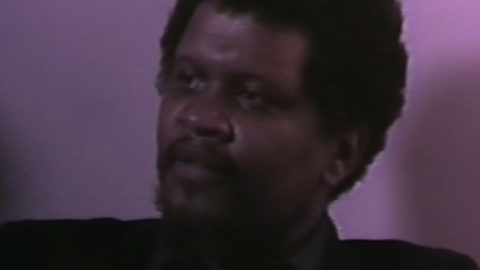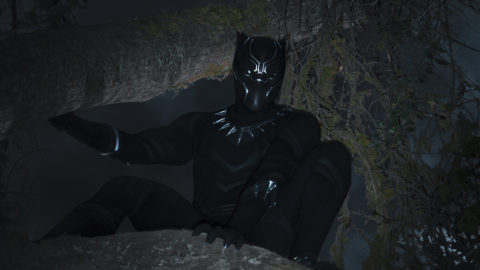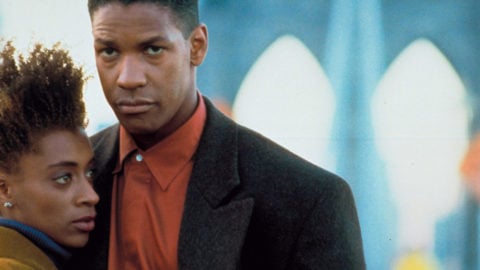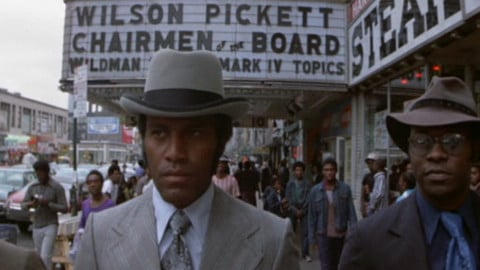By Teo Bugbee in the July-August 2018 Issue
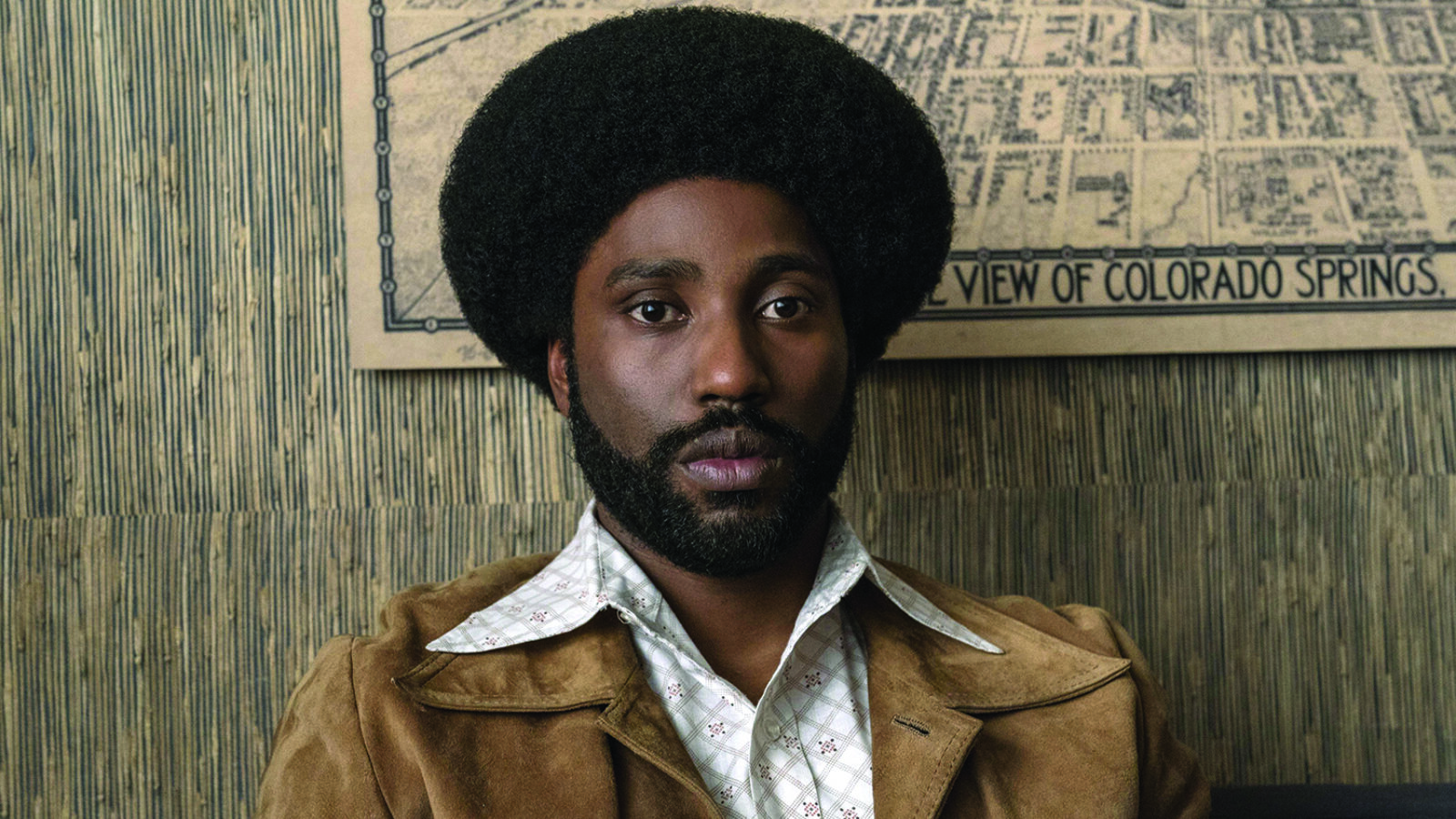
It Happened Here
Spike Lee’s galvanizing BlacKkKlansman taps the conventions of genre to grasp the country’s legacy of hatred—and resistance
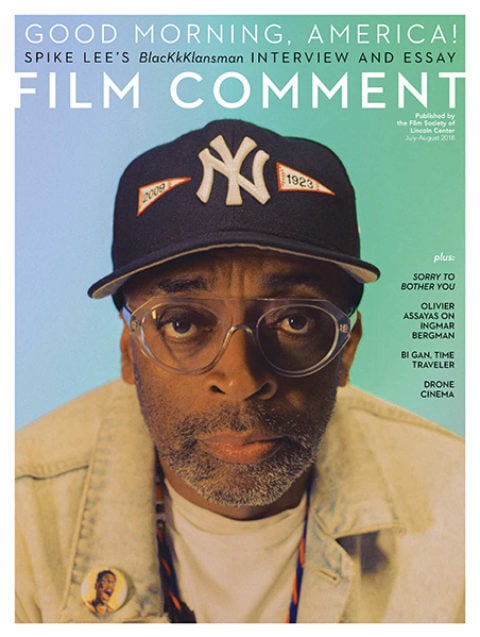
From the July-August 2018 Issue
Also in this issue
In a case where the events of history improve upon the fantasies of fiction, BlacKkKlansman, the latest Spike Lee joint, is based on the 2014 memoir written by Ron Stallworth, a black undercover police officer who infiltrated the Ku Klux Klan in 1979. True to the director’s lifelong interest in depicting black history, he hews close to the truth of the author’s accounts. Stallworth did become a card-carrying member of the Klan; he did wire a white police officer and send him to rendezvous with the Klan’s Colorado Springs chapter; and he did have an ongoing phone correspondence with David Duke, leading to an uncomfortable dilemma when he was assigned to be Duke’s bodyguard during the white supremacist politician’s trip to the local chapter.
However, Lee does not get lost in the details of Stallworth’s life story, and BlacKkKlansman is no straight biopic. Instead, it follows the beats of a traditional cop movie, where a man of the law is torn between allegiances in his efforts to solve a case. In this regard, the film represents the latest chapter in the underrated career of Spike Lee, genre filmmaker.
Many of Lee’s movies, like She’s Gotta Have It, Do the Right Thing, Crooklyn, and 25th Hour, have used the landscape, the neighborhoods, and the culture of New York City to provide structure for his style and storytelling. Much as his idol, playwright August Wilson, did in his famous Pittsburgh Cycle, Lee is well known for telling stories that use the hometown conflicts between neighbors to examine political ideas that expand beyond the lives of his characters. But just as frequently, he has explored existing genres, using the rigid formal structures of musicals, heist films, epic melodramas, vampire romances, and Aristophanian comedies to illuminate the social issues that drive his more narratively fluid city films. In movies like School Daze, Malcolm X, Bamboozled, and now BlacKkKlansman, Lee manages to crack the codes of genre storytelling, confronting audiences by placing the black experience at the center of familiar narratives.
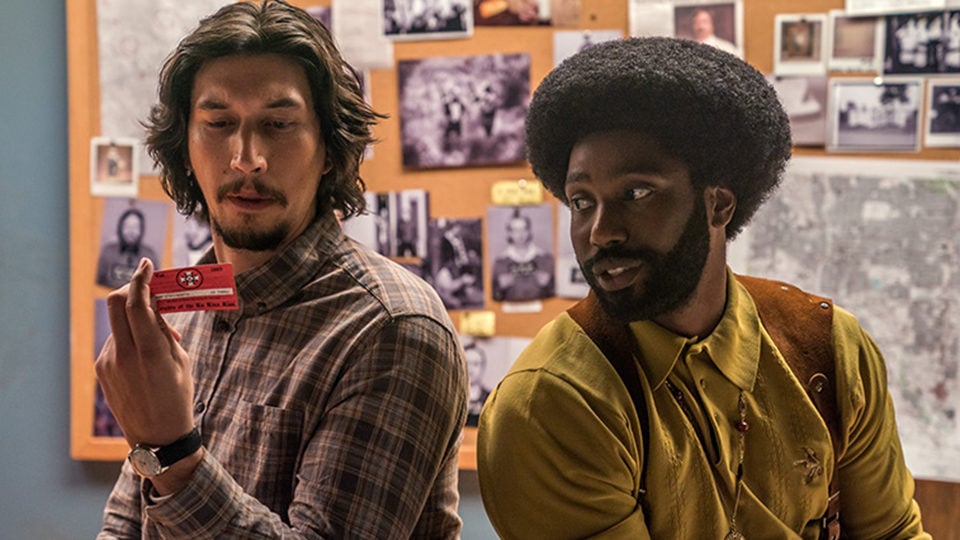
BlacKkKlansman
School Daze (1988) was Lee’s first experiment in setting his style within the confines of an established genre. He chose the musical to provide the format for his story about warring ideologies on black campuses. In a genre where ecstatic emotion drives characters to burst into song, the feelings that drive the musicality of School Daze are the anger, pride, and plain dumb horniness that consume these students, who are on the verge of leaving the bubble of their historically black colleges. Rather than the Sharks and Jets, Lee’s fictional Mission College has Gamma Phi Gamma and men who choose not to participate in Greek life, like the film’s hero, Dap Dunlap (Laurence Fishburne). Where hyper-masculine conflict exploded in Seven Brides for Seven Brothers at a barn-raising, and in West Side Story at a community dance at the local gym, the site for male display of aggression in School Daze becomes a step show. The black hair salon emerges as another war zone, erupting into song as “Jiggaboos” and “Wannabes” hurl accusations and insults from across the divide between straight and nappy hair, light and dark complexions.
With School Daze, Lee affirmed that there is something chemically, magically, mechanically, spiritually correct in the cinematic presumption that a person overcome with emotion should only be able to express that feeling through song. But the elation that comes from watching a beautifully choreographed musical scene is consistently and productively undercut by the surprising unfamiliarity of seeing a genre typically reserved for the most romantic images of white Hollywood repurposed to fit the social and political concerns of young black people. Beginning with School Daze and leading up to BlacKkKlansman, Lee’s best genre films use pastiche to directly respond to the disorientation of looking into film history and finding a void of black faces and black artistry. Like a fist that has been punched through a wall, the images in Lee’s genre films bust out from a history of cinematic suppression.
Lee returned to genre experimentation four years later to portray the life of Malcolm X. Rather than adhere to a realistic or contemporaneous approach to biography, one that would seek to re-create already famous images of the black separatist leader, Lee immersed himself in the epic Hollywood storytelling of filmmakers like David Lean, crafting a style for the film that would place Malcolm in the rarified realm of myth and melodrama. Color, light, and mise en scène would become subjective reflections of Malcolm’s dreams, visions, and self-image. As a child Malcolm is alone and diminished, crowded in the background of the frame as his white teachers demean his ambitions. His conversion to Islam brings the promise of milky-light salvation, a promise fulfilled only by the stark purity of the desert in Mecca. As an activist, Malcolm speaks with the Honorable Elijah Muhammad’s eyes blazing in a poster over his shoulder. The maximalism of Lee’s staging reflects the magnitude of Malcolm’s importance as a leader for black freedom. Aided by Denzel Washington’s spectacular performance, Lee makes the argument for Malcolm’s place among cinema’s great melodramatic heroes.
Where School Daze followed the freed unit form, which prioritized the integration of songs into the storytelling, and Malcolm X raised one man’s life to epic proportions, Bamboozled (2000) riffs on the backstage musical. Here, black television producer Pierre Delacroix (Damon Wayans) launches a minstrel show in an attempt to create a program so offensive that the network will have to fire him from the job he hates. But when the show becomes a hit, Delacroix defends his new cash cow as a satire, much to the horror of his black colleagues, who watch as the show enlivens racists and invigorates hateful stereotypes. True to the dishy back-and-forth between production and performance that defines the backstage genre, Lee cuts between appalling network meetings and the even more appalling broadcasts. His stagings of Delacroix’s minstrel show are nightmarish, with black faces distorted by makeup and sickening smiles, their costumes oversized and clownish, their set designs for outrageous slave productions sickening. The images Lee makes on Delacroix’s behalf are surreal, but when the film’s final sequence fills the screen with a montage of clips showing how black people have been portrayed in Hollywood throughout history, the images that were once disquieting become weighted down by their historic banality. As familiar stars like Bing Crosby and Fred Astaire smear paint onto themselves for blackface performances and Al Jolson sings for his mammy, Lee extends the eviscerating critique of his most trenchant film to include the very genre it occupies.
The results of Spike Lee’s more recent experiments with genre have been uneven. The heist film Inside Man (2006) was the director’s last big hit at the box office, offering him the chance to make a respectably budgeted thriller starring his frequent collaborator Denzel Washington, but he was working as a director-for-hire with minimal contributions to the script. In 2014, Da Sweet Blood of Jesus paid respectful homage to Bill Gunn’s dreamy vampire film Ganja & Hess, reexamining its ideas about addiction and the black bourgeoisie in the present day, but failing to evoke the warm eroticism and the spectacular performances of the original film. Meanwhile, Lee’s repurposing of Lysistrata in Chi-Raq (2015) results in a screen comedy rich in images, ideas, and especially language, but the movie feels like it exists in an entirely different universe than the circumstances that face the real Chicago, where it’s set.
BlacKkKlansman betrays no such awkwardness. The genre at play is the cop film, and the story follows many of the conventions that audiences familiar with modern examples like Point Break or L.A. Confidential might expect. There are good cops like Ron (John David Washington, Denzel’s son) and Flip (Adam Driver), who are anti-racist in their personal and professional lives, and there are bad cops, represented by the white police officer (Fred Weller) who taunts Ron and assaults the members of the black student union. Like the good cops of Hollywood potboilers past, Ron is continually faced with corrupt influences within the department, but the corruption in BlacKkKlansman doesn’t come from mysterious collusion with drug dealers or organized crime. Instead Ron’s investigation faces challenges from the white men in positions of power who refuse to examine their own biases, and from the (historically accurate) infiltration of white supremacists into American intelligence agencies.
In a divergence from the original memoir, Lee adheres to the conventions of the genre and introduces a love interest, a young woman named Patrice (Laura Harrier) who is responsible for bringing the Black Panther activist Kwame Ture (Corey Hawkins) to speak in Colorado Springs. Patrice acts as a mechanism to trigger Ron’s doubts, as her vision of black politics prioritizes granting power to all the people, challenging Ron’s ambitions to change the police from within the force. Patrice also becomes an important part of the action, as Lee introduces a plot to murder Patrice and other black activists, providing Ron’s investigation and the movie around him with a threat that propels the narrative forward.
The relationship between Ron and Flip also builds on the traditions of cop movies, introducing a buddy dynamic that opens the door to warm collegial comedy. When they first meet, Ron and Flip are an odd couple, foils that reveal each other’s character. Where Ron is brash, Flip is reserved. Ron sees the investigation of the Klan as a project of passion, where Flip approaches the case as a professional, rather than personal, undertaking. But Lee complicates this relationship by tying the characters together as representatives of oppressed minorities facing down those who want to see their destruction. Though Stallworth’s memoir never identifies the religion of the white cop who met with KKK members in Ron’s name, in Spike Lee’s version of the story, Flip is a non-practicing Jewish police officer. Flip’s ambivalent relationship to his own identity as a Jewish-American provides the film with one of its strongest storylines, one that raises the physical as well as emotional stakes, as Flip must conceal not only Ron’s true identity from the men he meets at the Klan meetings, but his own as well. When Ron enlists Flip in the investigation, he is putting his life in danger, and as a result of his proximity to Ron, Flip’s relationship to his own history and his own role as a police officer begins to change.
From scene to scene, lee meticulously manipulates the real history of Ron Stallworth, the police in America, and the Klan. The result is that BlacKkKlansman is a deeply entertaining and conventionally appealing movie that loses none of Lee’s signature political punch. It is as appropriate for malls and multiplexes as it was for the Cannes Film Festival, where it received the Grand Prix from Cate Blanchett’s jury. Were BlacKkKlansman only to include the 1979 story, it would still be a major achievement for Lee. But in the film’s coda, the director adds a grace note that reframes everything that came before it, giving one last insight into why it matters that this story about the Klan, the police, and racism in America should be told through a contemporary lens.
After Ron Stallworth has proven his mettle, after the day has been saved, and after his accomplishments have been undermined by his white bosses, he and Patrice are debating the merits of their relationship when they are startled by a knock on the door. Both pull out their guns, united from across an ideological divide against likely danger. But when they open the door, they are greeted with a long empty hallway. The walls close in around the camera, leading the audience closer and closer to the sight visible through the hallway window. It is a burning cross with Klansmen gathered, and Lee cuts in to observe their rapture, their eyes filled with flames.
From this image of euphoric hate, Lee mirrors the end of Bamboozled by throwing the audience into an assembled montage, this time with decidedly more modern footage. Where Bamboozled ended a disorienting dive into a satirical version of the present with a sobering view of the past, BlacKkKlansman reverses the journey, trading a coherent film about the past for a dizzying view of the present. Images from the 2017 Klan rally in Charlottesville, tiki torches, and skinheads overwhelm the screen; full-throated chants from real white supremacists on behalf of white power resound throughout the theater.
Much of the footage that flashes in these final moments of BlacKkKlansman was featured in a Vice documentary that received millions of views after the Klan rally in August. Notably, in their handling of this material, Vice also adhered to familiar patterns of generic convention. They chose a young journalist to be a fish out of water, sending her to speak to white supremacists who saw the rally as their opportunity to seize power. It was an explanatory exposé, designed to elucidate a tragic and chaotic moment in the recent history of race relations in America. But elucidation requires that a situation be made logical, and what is logical can easily become palatable or even convincing.
What was sinuously legible in the Vice documentary becomes chopped and screwed in Lee’s handling. The tight scripting and the light humor of the film that precede this montage only make the shock of disorientation more abrupt. But as the violence continues, the lessons from Ron Stallworth’s story provide a frame for the senseless horror of watching arms and bodies thrown into the air as a car rams into a crowd, taking the life of the nonviolent protestor Heather Heyer.
Slurs against Jewish people ring out alongside the anti-black chants, recalling the racism Ron and Flip have faced. And of course, David Duke speaks calmly amidst the pandemonium, just as mild-mannered but decidedly less farcical than when he was played in the film by Topher Grace. By placing formal storytelling right up against this cascade of decontextualized images, Lee suggests a perspective that is new in his long career. In BlacKkKlansman, genre provides an impersonal framework that allows Lee to remove himself from the heat of reality, preserving the possibility for coolheaded analysis even as the temperature of real world conflict is rising.
Purchase the July/August 2018 issue or subscribe now.
Teo Bugbee is a queer film and culture writer based in New York.



